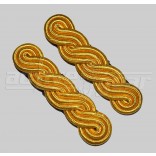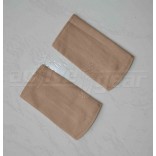Details
Peaked cap, Forage cap, Barracks cover, or Combination cap call it what you will, this is beyond the shadow of a doubt a symbol of authority and prominence for all those who are lucky enough to have earned the right to wear one. They are all forms of headgear worn by the armed forces of many nations and also by many uniformed civilian organizations such as law enforcement agencies.
The cap has a crown, a band, and a peak or visor (American English). The crown is one colour, often white for navies, light blue for air forces, and green for armies, and may be piped around the edge in a different colour. More often than not the band is a single colour, usually black, occasionally you may also see a striped cap for the band, the stripes could run either vertically or horizontally. Most caps have some form of cap device (or cap badge). In the British Army, each regiment and corps has a different badge. In the American armed forces, the cap device is uniform throughout the branch of service, though different variants are used by different rank classes. The peak or visor is short, historically made of leather, or in newer caps may be a shiny plastic resembling patent leather. Sometimes it is covered in fabric and depending on the rank of the wearer may be adorned with embroidered ornamentation.
The peaked cap was first sighted in the early 19th century Northern-Europe, usually worn by working class men. Around the same time in the later years of the Napoleonic Wars it began to appear in the senior ranks of the Russian and Prussian armies, and was popular because of its comfort and light weight, as opposed to the cumbersome bicorns and shakos that they were issued with for duty. For the entire 19th century peaked caps were popular with the working classes all over Northern-Europe, though in Britain the flat-top cap was preferred towards the end of the century. The US Army adopted the peaked cap during the Mexican-American war in 1846 due to the unsuitability of the shako in the hot Mexican climate. In 1856 a form of peaked cap was adopted by petty officers of the Royal Navy, in imitation of an undress headdress worn by officers from as early as 1827. The British Army adopted peaked caps in 1902 for both the new khaki field dress and (in coloured form) as part of the "walking out" or off duty wear for other ranks. A dark blue version was worn with dress blues by all ranks of the U.S. Army between 1902 and 1917. Early soldiers' peaked caps were, in fact, peakless, hence the nickname “soldier's flapjack” for the headgear; officers' caps had peaks from the start and looked like modern peaked caps. The cap was used in the early stages of World War Ias the primary headgear, but increased head injuries lead to their replacement with the Brodie helmet as primary combat head protection.
During the twentieth century the combination or peaked cap became a common headdress in the armies, navies, air forces and law enforcement agencies of the world, especially for officers. As a relatively practical and smart item it also became popular amongst police forces, largely replacing the helmets and kepis worn earlier.
Additional Information
| size | N/A |
|---|
You may also be interested in the following product(s)
-

Shoulder Boards
$39.99 -

Khaki Rank Slides
$2.49






